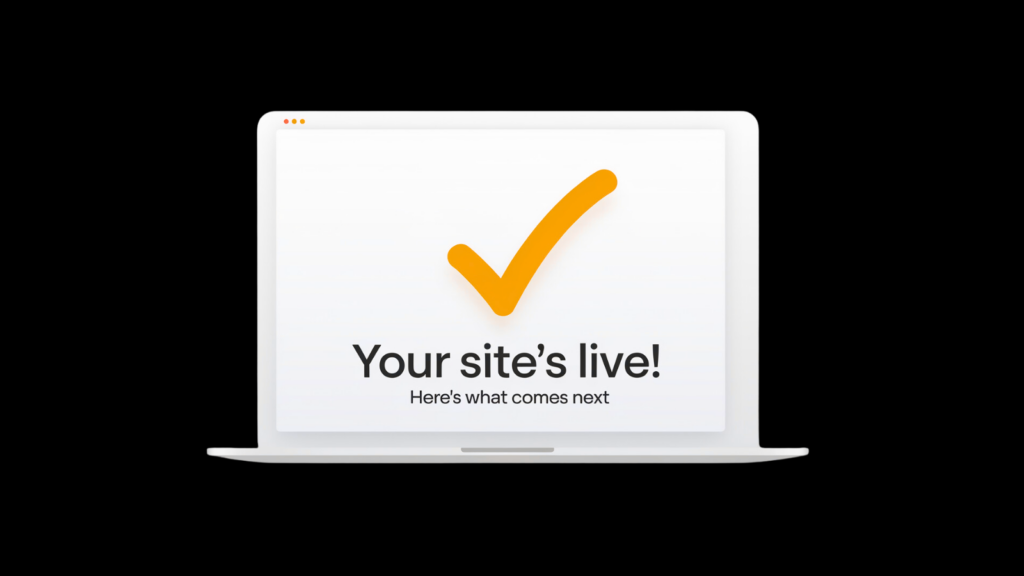
Congratulations! Your new website is up and running. But before you pop that champagne, there’s still work to be done to ensure your digital investment pays off. We’ve compiled a comprehensive guide to help you maximize your website’s potential from day one.
1. Share Your Success
The launch of a new website is a milestone worth celebrating. Take a moment to share this achievement with your team, stakeholders, and network. This isn’t just about patting yourself on the back – it’s about ensuring everyone knows your new digital storefront is ready to drive business growth. An aligned and aware team is better equipped to leverage this powerful new tool for making sales, generating leads, or sharing valuable information with your audience.
2. Quality Assurance Check

Ensure a flawless user experience by checking every link, form, and interactive widget. A missed link or a non-functioning form can easily lead to lost leads or a poor first impression. Use tools like Broken Link Check to save time when identifying dead links. Quick proofreading also helps catch any minor errors. This attention to detail ensures your site projects the professionalism you’re aiming for.
3. Performance Testing
Your website’s speed and mobile responsiveness are crucial to success. Studies show that 53% of mobile users abandon a site if it takes more than three seconds to load (Google). Utilize tools like Google PageSpeed Insights to analyze performance and identify improvements. The Mobile-Friendly Test ensures seamless usability across devices. Consider using optimization tools like WP Rocket and converting images to WebP format to boost speed – vital for user experience and search engine rankings.
4. Implement Backup Solutions
Protecting your new digital asset should be a top priority. Implement a comprehensive backup strategy with automated and manual backup options, both locally and in the cloud. A staggering 60% of small businesses go out of business within six months of a data loss event. Regular testing of your backup restoration process is essential – you don’t want to realize it’s not working when you need it most.
5. Analytics Setup
Understanding your website’s performance is crucial for ongoing improvement. Set up Google Analytics 4 to track visitor behavior, monitor conversion rates, and understand user journeys. Configure event tracking for key interactions and set up goals to measure your site’s effectiveness. Access to this data will be invaluable in making informed improvements.
6. Search Console Integration
Google Search Console is your window into how search engines see your site. Submit your sitemap to ensure Google indexes all your pages efficiently. SEO studies show that higher search engine visibility can increase traffic by over 100% in some cases. Monitor search performance, rankings, and SEO issues to enhance visibility.
7. Brand Monitoring
Stay informed about your site’s impact in the digital space by setting up brand monitoring. Google Alerts notifies you whenever your brand is mentioned online, helping you track your reputation and identify linking opportunities. Monitor social mentions to engage with your audience and track competitor activities to stay ahead. This awareness helps maintain and boost your online presence.
8. Maintenance Planning

Your website requires regular attention to maintain performance and security. Develop a systematic maintenance schedule that includes updates, content refreshes, and security checks. Research shows that 14% of cyberattacks target the exploitation of vulnerabilities, making maintenance critical. Regular check-ups prevent bigger problems down the road.
9. Email Marketing Integration
Leverage your existing audience by announcing your new site through email. Craft an engaging announcement highlighting new features and benefits for your users. Consider including a special launch promotion to drive traffic and engagement. Email is among the most effective marketing channels, boasting an average ROI of $42 for every dollar spent.
10. Social Media Optimization

Expand your digital footprint by integrating your new website with your social media. Update all your profiles to reflect the new web presence, and share launch announcements across platforms. Social media is powerful; 73% of marketers say it helps boost traffic. Regular engagement and a sound content strategy drive traffic and amplify your site’s reach.
11. Link Building Strategy
Start building your site’s authority with strategic outreach and relationship building. Platforms like HARO (Help a Reporter Out) connect you with bloggers and journalists. Focus on creating valuable, linkable content that attracts backlinks naturally. Quality is key in link building, as websites with strong backlink profiles rank higher on average.
12. Content Strategy
Keep your website engaging with a robust content plan. Studies show that businesses that publish 16+ blog posts monthly see nearly 3.5x more traffic than those publishing fewer (HubSpot). Plan regular updates addressing your customers’ needs and optimize for search intent. Fresh, relevant content keeps users and search engines coming back.
13. Monitor and Iterate
Launching your site is just the beginning of your digital journey. Implement systems to track performance and gather user feedback. Adjust your SEO and make informed improvements based on real data. With 70% of marketers investing in ongoing SEO, it’s clear that digital success requires constant evolution.
Ready to Take Your Website to the Next Level?
While these steps are crucial for post-launch success, implementing them effectively requires expertise and consistent attention. At 42Works, our website maintenance and optimization services ensure your site continues to perform at its peak.
Let Us Handle Your Post-Launch Success
Our team of experts can manage everything from regular maintenance to advanced optimization, allowing you to focus on growing your business. Contact 42Works Now | Learn About Our Website Maintenance Services
Looking for ongoing website support?
Our dedicated team ensures your site stays secure, fast, and optimized. Schedule a consultation to learn more about our maintenance packages.
FAQs
- Why is post-launch website maintenance important?
Regular maintenance keeps your website secure, fast, and optimized for the best user experience. - How often should I update my website content?
Aim to update content at least once a month to keep it fresh and relevant. - What’s the benefit of using Google Analytics?
It provides valuable insights into user behavior, helping you make data-driven improvements. - How can I improve my website’s loading speed?
Use image compression, and caching plugins, and optimize your code for faster load times. - What’s the purpose of Google Search Console?
It helps monitor your site’s SEO performance, and index status and identifies issues affecting visibility. - Is link building essential after launch?
Yes, building quality backlinks improves your site’s authority and search engine ranking.
How does social media benefit my website?
Social media drives traffic, increases brand exposure, and helps engage with a wider audience.


